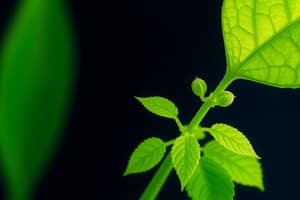Podcast
Questions and Answers
What is produced during the light-dependent reactions of photosynthesis?
What is produced during the light-dependent reactions of photosynthesis?
- Oxygen (correct)
- Starch
- Glucose
- Carbon dioxide
Where do the light-dependent reactions of photosynthesis occur in plant cells?
Where do the light-dependent reactions of photosynthesis occur in plant cells?
- Cytoplasm
- Chloroplast outer membrane
- Thylakoid membranes (correct)
- Stroma
What role do photosystems play in the light reaction of photosynthesis?
What role do photosystems play in the light reaction of photosynthesis?
- Gather light energy (correct)
- Fix carbon
- Store oxygen
- Convert glucose to ATP
What are some of the risk factors associated with thiamine deficiency?
What are some of the risk factors associated with thiamine deficiency?
Which food source is the richest in riboflavin?
Which food source is the richest in riboflavin?
Which of the following molecules are utilized during the dark reactions of photosynthesis?
Which of the following molecules are utilized during the dark reactions of photosynthesis?
What is the initial substrate in the shikimic acid pathway that reacts with erythrose-4-phosphate?
What is the initial substrate in the shikimic acid pathway that reacts with erythrose-4-phosphate?
What is the main purpose of the Calvin cycle in photosynthesis?
What is the main purpose of the Calvin cycle in photosynthesis?
How does riboflavin change when exposed to light?
How does riboflavin change when exposed to light?
Which enzyme catalyzes the conversion of shikimate to shikimate 3-phosphate?
Which enzyme catalyzes the conversion of shikimate to shikimate 3-phosphate?
Which of these best describes the light-independent reaction?
Which of these best describes the light-independent reaction?
What is one of the primary functions of riboflavin in the body?
What is one of the primary functions of riboflavin in the body?
Which aromatic amino acid is synthesized directly from the chorismate produced in the shikimic acid pathway?
Which aromatic amino acid is synthesized directly from the chorismate produced in the shikimic acid pathway?
During which stage of the Calvin cycle does carbon dioxide get fixed?
During which stage of the Calvin cycle does carbon dioxide get fixed?
Which vitamin is riboflavin also known as?
Which vitamin is riboflavin also known as?
Which of the following stresses can trigger the expression of aromatic compounds produced through the shikimic acid pathway?
Which of the following stresses can trigger the expression of aromatic compounds produced through the shikimic acid pathway?
What role does riboflavin play in vision?
What role does riboflavin play in vision?
What is the final product formed before the synthesis of aromatic amino acids in the shikimic acid pathway?
What is the final product formed before the synthesis of aromatic amino acids in the shikimic acid pathway?
What is the general chemical equation for the light reaction of photosynthesis?
What is the general chemical equation for the light reaction of photosynthesis?
What enhances the absorption of free riboflavin in the intestines?
What enhances the absorption of free riboflavin in the intestines?
What type of compounds are primarily produced via the shikimic acid pathway?
What type of compounds are primarily produced via the shikimic acid pathway?
Which of the following statements about riboflavin stability is correct?
Which of the following statements about riboflavin stability is correct?
Which carbon unit is associated with the synthesis of aromatic amino acids through the shikimic acid pathway?
Which carbon unit is associated with the synthesis of aromatic amino acids through the shikimic acid pathway?
Which of the following organisms utilizes the shikimic acid pathway for biomass production?
Which of the following organisms utilizes the shikimic acid pathway for biomass production?
What vitamin is referred to as niacin?
What vitamin is referred to as niacin?
What condition is caused by deficiency of niacin?
What condition is caused by deficiency of niacin?
Which of the following is NOT a form of vitamin B3?
Which of the following is NOT a form of vitamin B3?
What is one of the primary functions of niacin?
What is one of the primary functions of niacin?
Which statement about niacinamide is true?
Which statement about niacinamide is true?
What is the chemical classification of niacin?
What is the chemical classification of niacin?
Which of the following symptoms is NOT associated with deficiency in niacin?
Which of the following symptoms is NOT associated with deficiency in niacin?
Niacinamide can be used for which of the following purposes?
Niacinamide can be used for which of the following purposes?
What is another name for vitamin B5?
What is another name for vitamin B5?
Which of the following is NOT a function of vitamin B5?
Which of the following is NOT a function of vitamin B5?
Which food sources are rich in pantothenic acid?
Which food sources are rich in pantothenic acid?
What symptoms can arise from a deficiency in vitamin B5?
What symptoms can arise from a deficiency in vitamin B5?
Which of the following compounds is formed when pantothenic acid is hydrolyzed?
Which of the following compounds is formed when pantothenic acid is hydrolyzed?
Which vitamin is related to pyridoxol, pyridoxal, and pyridoxamine?
Which vitamin is related to pyridoxol, pyridoxal, and pyridoxamine?
Which statement about vitamin B5 is FALSE?
Which statement about vitamin B5 is FALSE?
Which of the following does vitamin B5 help synthesize?
Which of the following does vitamin B5 help synthesize?
Study Notes
Photosynthesis
- Photosynthesis is a two-stage process: light-dependent reaction and light-independent reaction.
- The light-dependent reaction occurs in the thylakoid membranes of chloroplasts.
- Photosystems I and II are involved in light-dependent reactions.
- ATP and NADPH are generated in light-dependent reactions.
- Water is used and oxygen is produced in the light-dependent reactions.
- The light-dependent reaction equation is: 2H2O + 2NADP+ + 3ADP + 3Pi → O2 + 2NADPH + 3ATP
- The light-independent reaction is also known as the carbon-fixing reaction.
- The light-independent reaction occurs in the stroma of the chloroplast.
- Carbon dioxide is captured from the atmosphere through stomata.
- The Calvin cycle converts 6 molecules of carbon dioxide into one glucose molecule.
- The light-independent reaction equation: 3CO2 + 6 NADPH + 5H2O + 9ATP → G3P + 2H+ + 6 NADP+ + 9 ADP + 8 Pi
The Calvin Cycle
- Consists of carbon fixation, reduction, and regeneration of the starting molecule.
- Carbon fixation involves capturing carbon dioxide.
- Reduction involves using NADPH and ATP to convert carbon dioxide into sugar.
- Regeneration involves regenerating the molecule used to capture carbon dioxide.
- C1, C2, C5, and C6-C3 units are formed during carbon fixation based on the number of carbon atoms.
Shikimate Pathway
- Biosynthesis of phenolic compounds, alkaloids, and other secondary metabolites is catalyzed by the shikimate pathway.
- This pathway occurs in chloroplast plant cells and is triggered by environmental stresses.
- The pathway starts with phosphoenol pyruvate and erythrose-4-phosphate.
- Chorismate, a substrate for the three aromatic amino acids, is the final product.
- The shikimate pathway is also known as the chorismate pathway.
Vitamin B2 (Riboflavin)
- Riboflavin, a yellow, heat-stable substance, is slightly soluble in water.
- It is sensitive to light and degrades into lumichrome or lumiflavin.
- Yeast is the richest source of riboflavin.
- Dairy products, eggs, legumes, and meats are good dietary sources.
- Riboflavin is stable during cooking in the absence of light.
- Riboflavin 5'-phosphate (FMN) and flavin adenine dinucleotide (FAD) are the forms found in foods.
- Active transport in the intestinal mucosa absorbs free riboflavin.
Uses of Vitamin B2
- Coenzyme in oxidation-reduction reactions for energy release from carbohydrates, fats, and proteins.
- Stimulates growth and reproduction.
- Plays a role in vision.
- Converts vitamin B6, folic acid, and niacin into their active coenzyme forms.
- Acts as an antioxidant by neutralizing free radicals.
- Deficiency causes stomatitis and dermatitis.
Vitamin B3 (Niacin)
- Niacin, also known as nicotinic acid or vitamin B3, is a pyridine derivative that prevents pellagra.
- Niacinamide (nicotinamide) also has anti-pellagra activity and is used for dietary and therapeutic purposes.
Vitamin B5 (Pantothenic Acid)
- Pantothenic acid, also known as vitamin B5, is a component of the B vitamin complex.
- It was historically known as the "chick antidermatitis factor."
- Animal organs (heart, kidney, liver) and cereal grains are good sources of pantothenic acid.
Uses of Vitamin B5
- Helps convert food into energy.
- Involved in the synthesis of lipids, neurotransmitters, steroid hormones, and hemoglobin.
- Contributes to tissue and cell maintenance and repair, particularly of skin and hair.
- Aids in healing wounds and lesions.
- Normalizes blood lipid profiles.
- Deficiency causes fatigue and sleep disturbances.
Vitamin B6
- Vitamin B6 encompasses three closely related substances: pyridoxol, pyridoxal, and pyridoxamine.
- They share similar physiological activity and are naturally occurring, highly substituted pyridine derivatives.
- Pyridoxine is the term commonly used for pyridoxol in pharmacy and medicine.
Studying That Suits You
Use AI to generate personalized quizzes and flashcards to suit your learning preferences.
Related Documents
Description
This quiz explores the processes of photosynthesis, focusing on the light-dependent and light-independent reactions. It covers key components such as ATP, NADPH, and the Calvin cycle, providing insight into how plants convert light energy into chemical energy. Test your knowledge on these critical biological processes.




